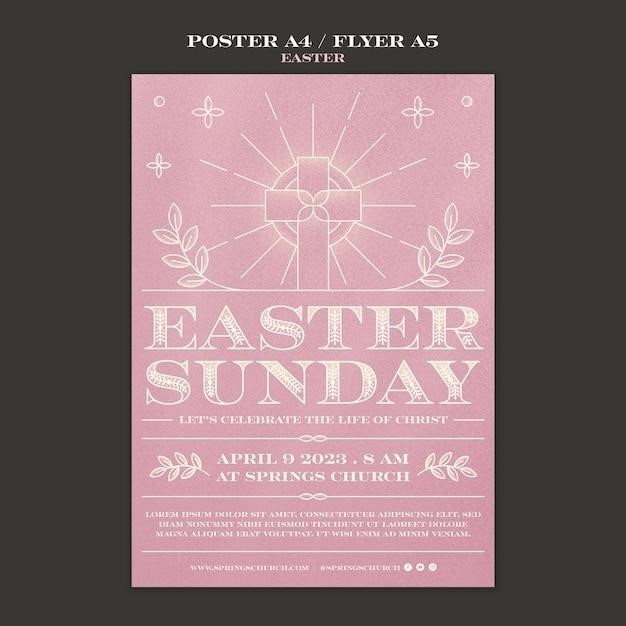christ be our light pdf
Christ, Be Our Light⁚ A Comprehensive Guide
This comprehensive guide delves into the beloved hymn “Christ, Be Our Light,” exploring its origins, lyrics, musical settings, use in worship, theological significance, impact, and legacy. We’ll examine its variations and adaptations, and provide resources for further exploration. Join us as we illuminate the depth and beauty of this powerful prayer song.
Introduction
“Christ, Be Our Light” is a modern hymn that has resonated deeply with Christians around the world. Composed by Bernadette Farrell, a renowned Irish composer and hymn writer, this powerful song is rooted in a Celtic prayer tradition and draws inspiration from Scripture, particularly the words of Jesus, “You are the light of the world” (Matthew 5⁚14). The hymn’s universal appeal lies in its evocative lyrics, which speak to the human longing for light, truth, peace, and hope in a world often shrouded in darkness. It’s a call to embrace the light of Christ, allowing it to shine within our hearts and illuminate our lives, transforming us into beacons of hope for others.
The hymn’s popularity has led to its widespread use in various liturgical settings, particularly during Easter Vigil services, where it often serves as a poignant reminder of the resurrection of Christ and the triumph of light over darkness. It is also frequently sung at other occasions, such as Advent services, as a reminder of the coming of the Light of the World, and during times of peace and reconciliation. The lyrics of “Christ, Be Our Light” offer a profound reflection on the transformative power of Christ’s presence in our lives, inviting us to become instruments of His love and grace.
Origins and Inspiration
The hymn “Christ, Be Our Light” finds its roots in the rich tradition of Celtic Christian prayer. Bernadette Farrell, the hymn’s composer, drew inspiration from a Celtic prayer that speaks of longing for light, truth, peace, and provision in a world often marked by darkness and hardship. The prayer’s simplicity and its focus on the transformative power of Christ’s light resonated deeply with Farrell, inspiring her to craft a hymn that would speak to the universal human desire for spiritual fulfillment.
Farrell’s lyrics echo the words of Jesus in the Gospel of Matthew, “You are the light of the world. A city set on a hill cannot be hidden. Neither do people light a lamp and put it under a bowl. Instead they put it on its stand, and it gives light to everyone in the house. In the same way, let your light shine before others, that they may see your good deeds and give glory to your Father in heaven” (Matthew 5⁚14-16). The hymn’s call to become “light for the world to see” is a direct response to this biblical mandate, encouraging Christians to live out their faith in a way that reflects the love and grace of Christ, bringing hope and illumination to those around them.

Lyrics and Meaning
The lyrics of “Christ, Be Our Light” weave together a tapestry of longing and hope, expressing a deep yearning for spiritual nourishment and guidance. The opening lines, “Longing for light, we wait in darkness,” set the stage for a hymn that speaks to the universal human experience of searching for meaning and purpose in a world often shrouded in uncertainty. The hymn acknowledges the darkness, both external and internal, that can cloud our vision and obscure our path.
The refrain, “Christ, be our light! Shine in our hearts; Shine through the darkness,” serves as a powerful plea for Christ to illuminate our lives, transforming our hearts and dispelling the shadows of doubt and despair. It speaks to the transformative power of faith, a light that can pierce through the darkness and guide us towards a brighter future. The hymn’s verses expand on this theme, exploring various aspects of spiritual longing, from seeking truth and peace to desiring provision for our physical and emotional needs.
The hymn concludes with a call to action, urging believers to be “light for the world to see,” embodying the love and compassion of Christ in their everyday lives. The lyrics of “Christ, Be Our Light” invite us to embrace the transformative power of faith, allowing it to shine brightly within us and illuminate the world around us.
Musical Settings
The musical settings of “Christ, Be Our Light” are as diverse as the communities that sing it. The hymn’s simple melody, composed by Bernadette Farrell, lends itself to a wide range of arrangements, from intimate solo performances to grand choral presentations. The repetition of the refrain, with its soaring melody, provides a powerful emotional core, creating a sense of unity and shared purpose among singers.
The hymn has been set to music in various styles, reflecting the different musical traditions and preferences of various churches and denominations. From traditional hymnody arrangements to contemporary gospel interpretations, “Christ, Be Our Light” has found a home in a multitude of musical settings. The hymn’s flexibility allows it to be performed with a variety of instruments, including piano, guitar, organ, and even handbells, adding depth and richness to its musical tapestry.
Many musical arrangements of “Christ, Be Our Light” incorporate the use of candles, symbolizing the light of Christ. This practice enhances the hymn’s message of hope and transformation, creating a powerful visual representation of the light that shines through the darkness. The hymn’s musical settings are a testament to its enduring popularity, its ability to resonate with diverse musical tastes, and its power to evoke a sense of shared faith and community.
Use in Worship
The hymn “Christ, Be Our Light” has become a staple in Christian worship, finding its place in a wide range of liturgical settings. Its powerful message of hope, peace, and the transformative power of Christ’s light resonates deeply with congregations across denominations. The hymn’s versatility makes it suitable for various occasions, from Easter Vigil services to Advent celebrations, and even during ordinary Sunday worship.
The hymn’s lyrical themes of longing for light, truth, and peace are particularly poignant during times of uncertainty and darkness. The refrain’s call to shine as a light for the world encourages believers to live out their faith in tangible ways, becoming beacons of hope and love in a world often shrouded in darkness. Its use in candlelight services, where the flickering flames symbolize the light of Christ, adds a powerful visual element, enhancing the hymn’s impact.
The hymn’s popularity extends beyond traditional worship settings. It is frequently used in small group gatherings, retreats, and even in secular settings where individuals are seeking solace and inspiration. The universality of its message and its accessibility through various musical arrangements contribute to its widespread appeal. “Christ, Be Our Light” continues to be a powerful and moving expression of faith, a reminder that even in the darkest of times, the light of Christ shines brightly, guiding us toward hope and transformation.
Theological Significance
The hymn “Christ, Be Our Light” carries profound theological significance, drawing upon core Christian beliefs about the nature of God, humanity, and salvation. The hymn’s central theme of Christ as the light of the world echoes the biblical imagery of Jesus as the “light of the world” (John 8⁚12), illuminating the path to salvation and offering hope in a world often shrouded in darkness. The hymn emphasizes the transformative power of Christ’s light, illuminating not only our physical surroundings but also our hearts and minds, guiding us towards truth, peace, and spiritual growth.
The hymn’s call to “shine through the darkness” encourages believers to become living embodiments of Christ’s light in the world, sharing their faith and love with others. This resonates with the concept of “salt and light” (Matthew 5⁚13-16), where believers are called to be a positive influence in the world, bringing hope and transformation. The hymn’s focus on “longing for truth” and “longing for peace” reflects the human condition of seeking meaning and fulfillment in a world marked by conflict and suffering.
Ultimately, the hymn’s theological significance lies in its affirmation of Christ’s redemptive power and the transforming grace that He offers. It invites believers to embrace their calling as disciples, to reflect Christ’s light in their daily lives, and to become agents of hope and change in a world desperately in need of healing and renewal. The hymn serves as a powerful reminder of the enduring presence of Christ, the light that shines even in the darkest of times, offering hope, guidance, and the promise of a brighter future.
Impact and Legacy
The hymn “Christ, Be Our Light” has had a profound impact on Christian worship and spirituality, leaving a lasting legacy that continues to resonate with believers around the world. Its simple yet powerful lyrics, combined with its accessible melody, have made it a beloved and widely sung hymn in various denominations and traditions. The hymn’s universal themes of longing for light, truth, and peace have struck a chord with people from diverse backgrounds, speaking to the shared human experience of seeking meaning and hope in a complex and often challenging world.
The hymn’s popularity has extended beyond traditional church settings, finding its way into interfaith gatherings, secular events, and even popular culture. Its use at candlelight services, Easter vigils, and other special occasions has created a sense of shared community and spiritual reflection. The hymn’s simple yet powerful imagery has inspired countless artistic interpretations, from stained glass windows and sculptures to paintings and musical arrangements, further solidifying its place in the cultural landscape.
The enduring legacy of “Christ, Be Our Light” lies in its ability to connect with people on a deeply personal level, offering a sense of solace, hope, and inspiration. It serves as a powerful reminder of the transforming power of faith, the enduring presence of God’s love, and the call to live as beacons of light in a world often shrouded in darkness. The hymn’s impact continues to be felt in communities around the world, fostering spiritual growth, building bridges of understanding, and reminding us of the transformative potential of living in the light of Christ.

Variations and Adaptations
The enduring popularity of “Christ, Be Our Light” has led to a variety of variations and adaptations, reflecting the hymn’s versatility and adaptability to different musical styles and contexts. These variations demonstrate the hymn’s ability to resonate with diverse audiences and to be interpreted in ways that speak to specific needs and experiences.
One common adaptation is the use of different musical settings. The hymn has been arranged for various instruments and vocal ensembles, from solo piano and voice to full orchestra and choir. These arrangements often incorporate unique harmonies, rhythms, and instrumentation, adding new dimensions to the hymn’s musical expression. For example, some arrangements incorporate traditional Celtic melodies, reflecting the hymn’s roots in Celtic spirituality, while others draw upon contemporary musical styles, making the hymn accessible to a wider audience.
Another common variation is the inclusion of additional verses or refrains. Some adaptations incorporate verses that address specific themes or events, such as peace, justice, or the environment. Others introduce new refrains or call-and-response sections, enhancing the hymn’s participatory aspect and inviting congregational engagement. These variations allow the hymn to be tailored to specific worship services, special occasions, or thematic celebrations, making it a flexible and adaptable tool for spiritual expression. The hymn’s adaptability demonstrates its enduring relevance and its ability to speak to the evolving needs and aspirations of believers in different times and places.
Resources for Further Exploration
For those seeking to delve deeper into the world of “Christ, Be Our Light,” a wealth of resources is available online and in print. These resources provide a rich tapestry of information, from musical scores and recordings to scholarly articles and theological reflections.
For those interested in the hymn’s musical aspects, online platforms like Hymnary.org and SheetMusicPlus offer a diverse collection of arrangements for various instruments and vocal ensembles. These platforms allow users to explore different musical settings and to download scores for personal use or for use in church services. Additionally, numerous recordings of “Christ, Be Our Light” are available on streaming platforms like YouTube and Spotify, showcasing the hymn’s versatility and its interpretation by various artists and ensembles.
For those seeking a deeper understanding of the hymn’s theological significance, several scholarly articles and books explore its themes, symbolism, and historical context. These resources delve into the hymn’s roots in Celtic spirituality, its connection to the Easter Vigil, and its broader implications for Christian faith and practice. Additionally, many websites and blogs dedicated to hymnody provide insights into the hymn’s origins, its author Bernadette Farrell, and its place within the broader landscape of Christian hymnody. By exploring these resources, individuals can gain a deeper appreciation for the hymn’s rich history, its enduring relevance, and its profound impact on Christian worship and spirituality.
